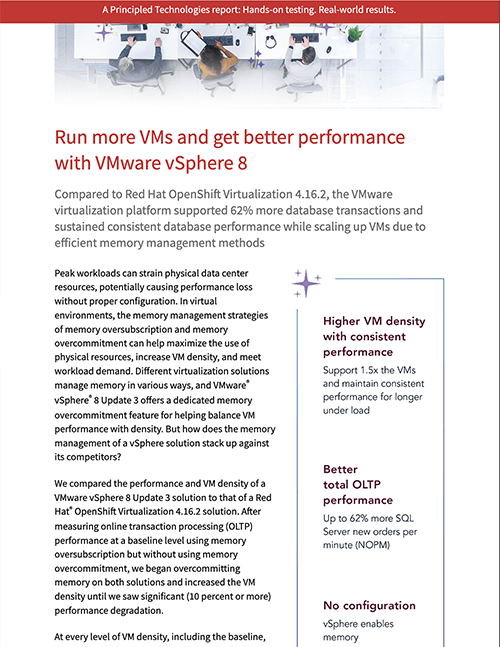
Server VMs give data center admins the power to extend the capabilities of physical servers by consolidating virtual environments, improve resource distribution and utilization, and rapidly scale up or down VM density in response to shifting workload demands. That type of flexibility can help prevent service interruptions and ensure sustained performance levels under peak demand--but VM management is not as simple as cranking the resource availability throttle up and down. Administrators must fine-tune the balance between transaction processing and VM density to maximize performance without causing performance degradation. Memory management strategies such as oversubscription and overcommitment can play an important role in finding that balance, but not all virtualization solutions manage memory in the same way.
We compared the performance and VM density of a VMware vSphere 8 Update 3 solution to that of a Red Hat OpenShift Virtualization 4.16.2 solution to see how each solution handled memory oversubscription and overcommitment. In our tests, both solutions used the same Dell PowerEdge R650 server in the same hardware configuration; only the virtualization platform differed. We first measured the online transaction processing (OLTP) performance of each solution at a baseline level using memory oversubscription but without memory overcommitment. We then began overcommitting memory on both solutions and increasing the VM density until we saw performance degradations of at least ten percent.
At every level of VM density in our tests, the vSphere solution outperformed the OpenShift solution, delivering up to 62 percent more new orders per minute at the maximum supported VM density of each solution. The vSphere solution also supported 1.5 times more VMs than the OpenShift solution and doubled the VM count before experiencing significant performance degradation. In addition to the better OLTP performance, we found that vSphere was easier to configure and required no additional tuning for memory overcommitment—a feature available by default.
Our results indicate that with the ability to support more VMs and achieve better OLTP performance, a VMware vSphere 8 Update 3 environment can help organizations meet more transactional database demand while maximizing server memory utilization.
To learn more about the benefits of memory management with VMware vSphere 8 Update 3, check out the report below.
Principled Technologies is more than a name: Those two words power all we do. Our principles are our north star, determining the way we work with you, treat our staff, and run our business. And in every area, technologies drive our business, inspire us to innovate, and remind us that new approaches are always possible.






